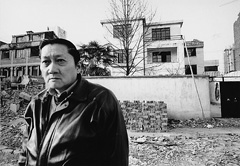Last House Standing
 CHINA / 2004 / Mandarin / Color, B&W / Video / 54 min
CHINA / 2004 / Mandarin / Color, B&W / Video / 54 min
Directors: Gan Chao, Liang Zi
Photography: Liang Zi
Camera Assistants: Zhu Qian, Gan Chao
Editing: Gan Chao
Sound Editor: Shen Hancun
Art Director: Yu Mengliang
Executive Producer: Yuan Yemin
Producer: Wang Xiaolong
Production Company, Source: Shanghai TV Station
Mr. Jiang is a Shanghai dandy, living by himself in a house that stood the test of time since the 1930s as a witness to what happened to the city. Now, the house is about to be torn down as part of a redevelopment plan. A woman becomes a tenant and fiercely pursues the taciturn man, until he opens his mouth unraveling his unique philosophy and personal history. Combined with the verbal sparring between the two and the scenes around the house, the sadness that oozes from Mr. Jiang’s life at the mercy of Chinese history—Shanghai during the war, the fury of the Cultural Revolution, and now the present—casts a subtle shadow over the film.
[Director’s Statement] The filming and production of Last House Standing took two years. It was a difficult process given the monetary constraints we were working under. However, from the first day of filming, our hearts and minds were won over by the story of Mr. Jiang and his house. We found ourselves filming a historical memoir, even if it is from a person of anonymity.
Every hardship this old man and his house had gone through was closely connected to China’s own historical adversities at the time. The old mansion bore witness to the decadence of 1930s Shanghai, its liberation after the civil war, and the storms of the Cultural Revolution and continues to watch over the vast changes occurring in modern day Shanghai. The house is no longer a mere inanimate object, but a living blend of history, family and emotions that has dumped its burden on Mr. Jiang to bear alone in a cycle that has lasted sixty years. His history is the history of the Chinese society. In the film, every sigh and remembrance by him represented our own thoughts of our lives and past.
When this film was broadcasted in Shanghai, it was received with unprecedented enthusiasm. Perhaps this is because the film told the truth, or maybe it helped release the emotions that people had held in for many years. I believe that in our neighbor, Japan, the audience will completely understand the message of this documentary—this documentary is not only about someone else, it is also about ourselves. Like the question asked by Last House Standing: Who can escape history and live?
 Gan Chao
Gan Chao
Having graduated from the Dept. of Chinese Language and Literature at Shanghai’s Fudan University in 2000, Gan Chao continued his studies to receive a master’s degree in television studies at the University of Bristol two years later. That same year he directed the documentary More, or One. Other works include Entrance to Solitude (2003) and Come and Dance, Burka. He also works as a director, editor and producer at Shanghai TV Station’s Documentary Channel.  Liang Zi
Liang Zi
After working as a photographer and reporter in China’s Qing Hai region and in Tibet during the early 1980s, in 1990 Liang Zi was appointed chief photographer of the magazine Jingxiu, and published An Open Diary in Japanese in 1999. Between 2000 and 2003, she spent a total of one year and three months in the African countries Lesotho, Sierra Leone and Eritrea filming Africa Is Right Here (2000), Go for Africa (2001) and Sea and Sand (2003) respectively. |
